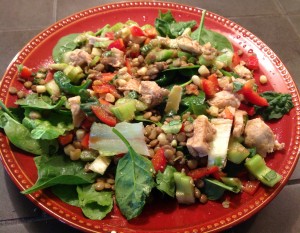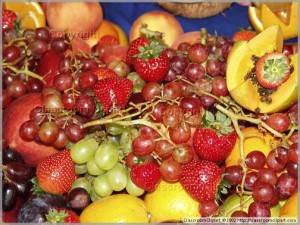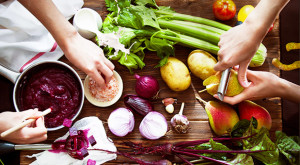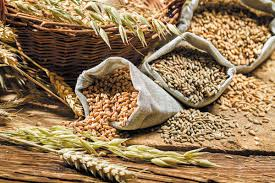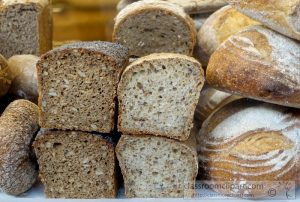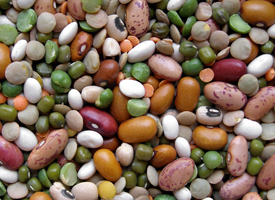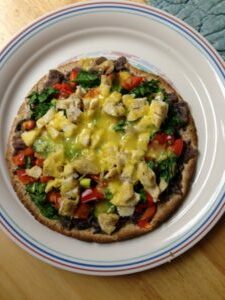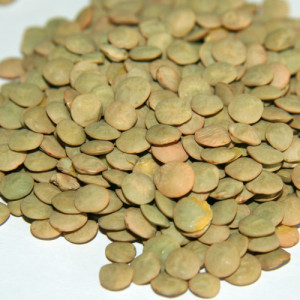Eating or Diet for a Healthy Heart, Step 1
Eat whole foods, avoid processed foods!
Healthy Eating Plans that have been shown to decrease risk for heart attack and stroke include:
- whole vegetables and fruits,
- whole grains
- legumes (beans/lentils/peas)
- Nuts and seeds
- heart healthy fats (liquid oils, fatty fish, nuts, seeds, avocado)
Healthy Eating Plans that have been shown to decrease risk for heart attack and stroke limit highly processed foods:
- LIMIT foods made with white flour
- LIMIT high sugar foods like “fruit snacks”, cakes, cookies, candies
- LIMIT processed snack foods such as chips and Cheetos, “Movie Popcorn”
- LIMIT processed meats such as bologna, hot dogs, salami, highly salted deli meats
These eating plans are high in potassium, heart healthy fats (see Healthy Heart Part 3), and relatively low in sodium (salt) and solid fats. They meet nutrient needs with foods rather than supplements. They tend to limit (not totally avoid) animal protein, especially red meats and encourage a largely plant based diet.
Two examples:
- DASH (Dietary Approaches to Stop Hypertension) Diet: https://www.nhlbi.nih.gov/health-topics/dash-eating-plan
- Mediterranean Diet. https://www.nhlbi.nih.gov/health-topics/dash-eating-plan; https://www.mayoclinic.org/healthy-lifestyle/nutrition-and-healthy-eating/in-depth/mediterranean-diet/art-20047801
These “diets” are fairly similar. The one difference is that the “DASH diet” encourages regular intake of low or non-fat dairy products for meeting calcium needs. Meeting calcium needs with food has been shown to help lower blood pressure.
Here are some ways to incorporate eating for a healthy heart into YOUR life.
Vegetables and Fruits:
Lots of research shows the benefits of eating a lot of vegetables and fruits for heart health. We need to eat WHOLE vegetables and fruits to get maximum benefits. Supplements and juices just don’t have the same effects. https://www.ncbi.nlm.nih.gov/pmc/articles/PMC4145465/; https://www.bmj.com/content/349/bmj.g4490
- Vegetables and Fruits help keep your heart and blood vessels healthy because of their high concentration of antioxidants, vitamins and minerals, especially potassium. Other nutrients in vegetables called “phyto-nutrients” also play a role in making are hearts and blood vessels healthy as well as helping prevent eye disease and many cancers.
- Vegetables are not only high in nutrients, they are very low in calories; eating a lot of them helps fill us up without causing weight gain. We should all aim for at least 5 servings of vegetables each day, some research suggests that eating far more vegetables has further benefits to our health. One serving of vegetables = 1/2 cup cooked or 1 cup raw. https://loribrizee.com/2017/01/tips-to-get-your-kids-to-eat-more-vegetables/
- Fruits are higher in calories than vegetables but much lower in calories than any typical snack food! For example: a typical granola bar contains 180 to 220 calories, while a medium sized apple, orange or peach contains only about 90 calories and a very large apple, orange or peach contains only about 150 calories–what is going to fill you up more and give you more vitamins and minerals–a granola bar or a piece of fruit? Fruits are a great way to satisfy your sweet tooth, and need little preparation before eating. We should all aim for at least 2 servings of fruit each day. One serving is a medium sized piece of fruit or 1 cup of diced fruit or berries.
How to Eat More Vegetables and Fruits:
Increasing vegetables and fruits takes some planning! Here are some ideas to get more of them in your life:
- Buy a raw veggie platter at the grocery store; add a handful of raw veggies to lunch and dinner and have a few when you want a snack.
- Buy bags of frozen vegetables. Heat one cup per person in the microwave to go with whatever you are preparing for dinner. Add frozen veggies to premade soups, macaroni and cheese, etc.
- Buy prewashed raw spinach or other greens and add them to scrambled eggs, soups, casseroles
- Order a green salad whenever you go out for lunch or dinner.
- Order sliced tomatoes in place of hash brown or fried potatoes when you go out for breakfast.
- Buy pre washed lettuce and cherry tomatoes to mix together for a quick green salad.
- Buy fresh fruit that is in season (it is less expensive and tastes better than fruit that is not in season), add fruit to meals and snacks and eat in place of dessert.
- Buy frozen berries and other fruit when they are not in season; use them as topping for yogurt, cereal, pancakes, ice cream, cake–desserts that contain fruit are healthier than those that don’t.
Whole grains
Eating whole grains gives us fiber, B vitamins, iron and fills us up with fewer calories than foods made with refined grains. The fiber in whole grains helps lower cholesterol and keeps our guts moving. That fiber also feeds our “microbiome”, the good bacteria that live in our intestines (the pet that is always with us!). That good bacteria helps keep our immune system strong. Recent research suggests that it also helps prevent Type 2 Diabetes and other diseases.
How to Eat More Whole Grains:
- Try cooking whole grains and freezing them so they are ready to add to any meal: whole wheat berries, cracked wheat, wheat bulgur, millet, brown rice, quinoa, oats, barley are just a few to try. ‘Bob’s Red Mill’ produces all of these grains and more, and provides excellent cooking instructions and recipes that use each type of grain, https://www.bobsredmill.com/
- Use any type of whole grain as a hot breakfast cereal or add to salads, soups, stews and casseroles.
- Switch from white to 100% whole grain breads, rolls, or tortillas. Look at different varieties and choose products that have whole wheat or whole grain first on their ingredient lists.
- Switch from refined to whole grain cereals grain cereals (e.g., bran flakes in place of corn flakes; plain Cheerios in place of Rice Krispies; oatmeal in place of Cream of Wheat)
- Eat popcorn rather than chips for a snack (good brand for a quick to eat snack; ‘Skinny Pop’; or make your own)
- Remember that sweet corn is a fantastic, easy to prepare whole grain. Eat it as corn on the cob, or steamed frozen corn for a quick addition of a whole grain to your meal.
Legumes
Beans, peas and lentils are some of the healthiest foods going! High in B vitamins, potassium, protein and fiber, and low in cost makes them a good bang for your buck! Legumes are another food that feeds your microbiome (that pet that lives inside of you). Yes, they do cause gas. Try to build up your tolerance by starting with small amounts (e.g. 1/4 cup serving added to a salad or mixed in with another food).
How to Eat More Legumes:
- Keep canned beans in your pantry, OR cook a large batch of dried beans and freeze them in single serving portions.
- Add beans to salads and cooked vegetables
- Add beans to casseroles
- Use seasoned beans for taco filling, OR mix 2 cans beans with each 1 lb of meat you prepare for tacos.
- Use beans as a base for soups (even if you plan to add meat)
- Try edamame (immature soy beans) as a snack.
Practical ways to get more vegetables and fruits, whole grains and legumes in your life:
- Breakfast:
- Whole grain cereal topped with plain Greek yogurt, almonds and 1 cup fresh or frozen berries (thaw in microwave to bring juice out).
- Scrambled eggs, omelette or frittata made with 1 cup finely chopped raw or frozen chopped vegetables , plus whole grain toast and a piece of fruit.
- Lunch:
- Sandwich on whole grain bread with 2 leaves of romaine or green leaf lettuce + 1 cup of vegetable and bean soup.
- Large green salad topped with 1 cup of kidney, black or garbanzo beans, 3/4 cup frozen corn and 1/2 can tuna or salmon
- Afternoon snack:
- Raw veggies with hummus (hummus is made from garbanzo beans).
- Piece of fruit.
- Popcorn (home-made or low salt commercial variety)
- Dinner:
- Whole wheat or brown rice spaghetti with 2 cups sauce made with canned tomatoes and/or tomato paste or tomato puree, bell pepper, onion, garlic, mushrooms as well as your choice of ground meat or lean Italian sausage + a large green salad (2 cups lettuce + carrots, cauliflower, cucumber and tomato–whatever you like), topped with your favorite salad dressing.
- Black beans cooked with onion, bell peppers, garlic and spices over brown rice, topped with 2 cups chopped lettuce and tomato + grated cheese and salsa.
- Baked salmon + sweet potato + 1 cup cooked veggies.
- Dessert or evening snack:
- Wedge of melon, piece of fruit, or cup of berries and a piece of banana bread made with whole wheat flour.
Note all the vegetables, fruit, whole grains, and legumes in these menu ideas! This may be a bit overwhelming, but start by using one or two ideas from this menu each day. Better yet, just start experimenting with getting a few more of these foods in your meals and snacks each day.
Check out Healthy Heart parts 3 and 4 to learn more about how fats and carbohydrates affect your heart health.

